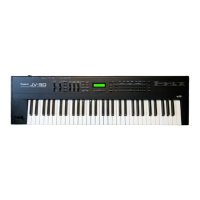Using MIDI 1
[About MIDI]
MIDI (Musical Instrument Digital Interface) is an internationally recognized
standard formulated
to
provide for the transfer of performance information
among electronic musical instruments and computers. When MIDI, music is
not handled as sound itself. Instead, performance information
and what-
ever commands
accompany
it
are
converted
and expressed in digital form.
Any device equipped with MIDI connectors, regardless
of
differences
in
model or manufacturer,
can exchange whatever performance data they are
both equipped to understand, once MIDI cables have been used to make the
correct
connections. For example, the JV-30 can be used to play another
separate keyboard, or a sequencer could provide
the data necessary to play
the JV-30.
[Making the
Connections]
9
Playing
the JV-30 and Another Unit Simultaneously
Connect the units together
as shown below. Then, whenever you play the JV-30, not only will
it
sound, but the other
unit
will receive that performance information and play the same notes.
This
type
of connection is
referred to as the "One-way" method.
The unit that transmits the performance information is
called
the
"master," whereas the unit
receiving
the information is known as the "slave."
MIDI Cable
OUT
,.
IN
amsrararall
'—
'
rsiiillill
mCDotatdmoEi aaDo
dooooooDao
^
o o
1'
—Sound: Module^
i^
rrri
1! !!! If !lf II III II III II III
Connecting
the JV-30 to a Sequencer
Connect the JV-30 and
a sequencer (such as the MC-50)
as
shown
below. Then, once
you get
the
sequencer ready to record, whatever performance
information you generate
(play) using
the
JV-30's keyboard will be recorded into the
sequencer.
If your
sequencer provides a Soft Thru function,
you
should
turn it ON. Local Control
(»
p.35)
on the JV-30 should also
be OFF. (If your sequencer does'nt
provide Soft Thru function,
you
should turn it
ON.)
This
type of connection is considered
as an alternate form of the
"One-
way" method. When recording, the
JV-30 is the master, and the
sequencer is the slave. During
playback, their roles
are reversed.
The connections can
be
made in
the same way when using
a computer-based
sequencer.
OUT
"
. IN
OUT
" •
IN
0S°@fflS"
'—
' osssssssss
CDGjoCDcauJoo
oooo oooooooooo
II (f^
encer"^
C3C3 add
ac3 c=ioi=i
a a (=1
i-n—
1
II III
II
III 1!
Ill
II
III
II III
—
Seat
cmt-ii-ii-JLi
cuoooo
C3
OC3
C3
30

